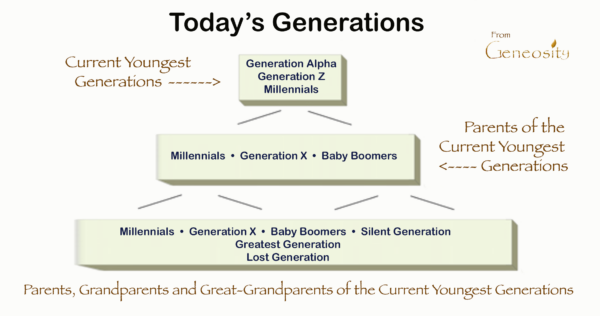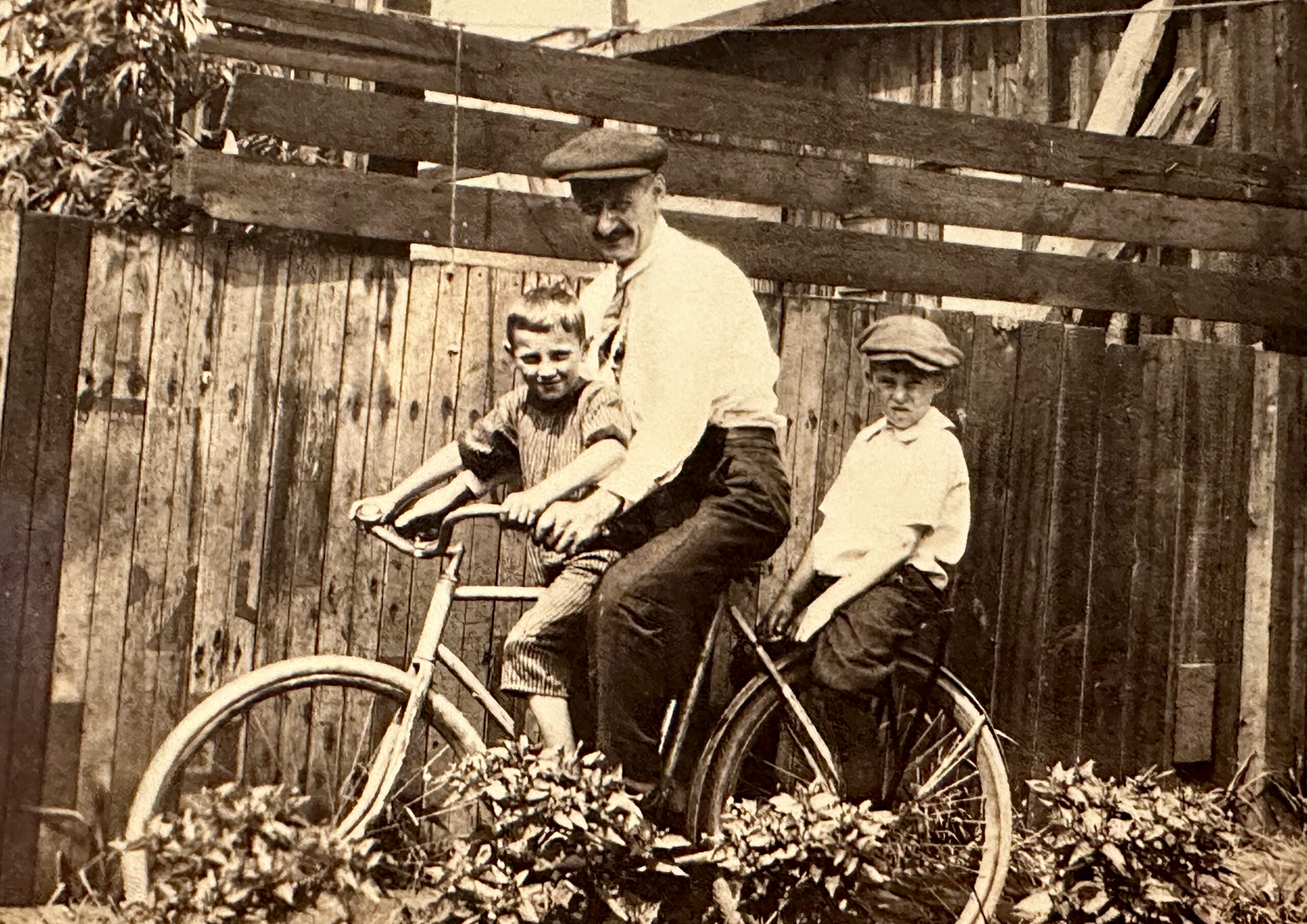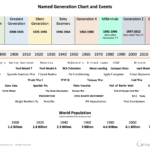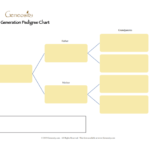The names of generations first began to appear in the middle of the 20th century from the works of writers and journalists in the Western world. Today, generation names such as “Baby Boomers” are in such widespread use that they have gained general acceptance. A genealogical generation can be gauged roughly from 20 to 30 years but the “named generations” range in 15 to 20-year increments.
Below are the named generations and years that are commonly referred to. The dates of birth years that are associated with each generation are:
- Lost Generation: 1880-1900
- Greatest Generation: 1900-1925
- Silent Generation: 1925-1945
- Baby Boomers: 1946-1964
- Generation X: 1965-1980
- Millennials (also known as “Generation Y”): 1981-1996
- Generation Z (also known as “Gen Z” or “Gen Zers”): 1997-2012
- Generation Alpha: 2010-2025
It’s worth noting that these birth year ranges are not set in stone and will vary slightly depending on the source. Additionally, these generations are not official definitions and are not used by demographers or sociologists in a formal sense. These are labels that have been popularized by the media and are used to refer to groups of people based on their age and the cultural events and trends that have shaped their experiences. Our Chart of Named Generations and Years provides a colorful visual timeline of these generations and some of the events that occurred in their lifetimes. These are very useful in genealogy study because these will help illustrate various dispositions (and events persuading the dispositions) of various family tree segments.

While the named generations aren’t standardized, they do provide valuable distinctions between members of varying generations by birth date. In genealogy, a generation is specifically the difference in age between a mother and a child and varies from family to family. Notable factors in the events of someone’s life does indeed shape their perspective, and this is where named generations earn their purpose. A useful understanding of the time in which someone lived can shed light on their moral values, decision-making, and state of mind.
For comparison, the Greatest Generation was impacted by the Spanish Flu in a similar way that Millennials were affected by COVID. Fear for a parent’s well-being and in some cases prematurely assuming a more mature role in family are possible commonalities of these generations. The 1918 Spanish Flu was fatal for more 25-40 year-olds than any other age group, squarely targeting the parents of the Greatest Generation. Mortality rates were highest for COVID in individuals aged 65 and over who in many cases were the parents of Millennials.
Lost Generation
The “lost generation” is a term that is often used to refer to a group of writers, artists, and all others who were born in the 1880s and 1890s that came of age during World War I. This generation is so called because many of them felt disillusioned and disconnected from the values and traditions of the past, and because they were often struggling to find their place in a rapidly changing world. The term “lost generation” was popularized by the writer Gertrude Stein, who used it to describe the young people she knew in Paris in the 1920s. Stein and many of her contemporaries felt that the war and Spanish Flu pandemic had destroyed the sense of stability and purpose that had previously guided their lives, and that they were left feeling lost and adrift as a result.
The Lost Generation is also called the G.I. Generation in texts by the renowned generational theorists Neil Howe and William Strauss.
Writers and artists of the Lost Generation” are often remembered for their contributions to modernist literature and art, and for their experimentation with new styles and forms. Some of the most famous members of the “lost generation” include Ernest Hemingway, F. Scott Fitzgerald, and T.S. Eliot.
Greatest Generation
The “greatest generation” is a term used to refer to the generation of people who were born roughly between 1900 and 1925. This generation jointly witnessed the Great Depression and World War II. The eldest members also had a front row seat to World War I and the Spanish flu pandemic. This generation is typically thought of as having a strong sense of duty, responsibility, and loyalty, and is often described as being hard-working, self-sacrificing, and patriotic. Notably, duty and responsibility were very common themes of this generation because the state of the world at the time demanded these.
The term “greatest generation” was popularized by the journalist Tom Brokaw, who used it as the title of a book he wrote about this generation. The book tells the stories of men and women who lived through some of the most challenging and transformative events in modern history, and who helped to shape the world we live in today.
Radio entertainment and pizzerias were “in” for the Greatest Generation. Polio and crank starting automobiles made their pesky way out later in the lives of these folks. The term “cranky” in fact was coined as a term describing the mood of frustration that hand-cranking a car often caused.
The Greatest Generation is currently the most popular demographic in ancestry and genealogy study. These are the grandparents and great-grandparents of individuals who are the most likely to be researching their family tree today. Every individual has 8 biological great grandparents and this segment of a family tree is a particularly extensive branch of research.
Silent Generation
The “silent generation” is the generation before Baby Boomers. The Silent Generation are people who were born between the mid-1920s and the early-to-mid-1940s. This generation name is characterized so because they were seen as being more reserved and less inclined to speak out on political and social issues compared to the baby boomers, who came of age during the 1960s and were known for their activism and counter culturalism. Members of the silent generation grew up during or were greatly influenced by the Great Depression and World War II and are often described as being hard-working, practical, and disciplined. They are also sometimes referred to as the “loyal generation,” because they are seen as being more loyal to institutions and more respectful of authority than some of the generations that followed them.
The Silent Generation witnessed the transformation from radio entertainment to television. The conservative nature of early television reflects their demeanor. Millennials in contrast came of age in the early 2000s when live streaming and media produced by more common people became widely available, inviting uncensored and less restrictive means of expression. Many of the Silent Gen born in the late 1930s and early 1940s confuse themselves as being referred to as Baby Boomers. This is the result of the term being more well-known, and the fact that marketing companies have used this term to identify with anyone over 65 years of age since around 2010.

Baby Boomers
The term “baby boomers” refers to the demographic of people who were born between 1946 and 1964. This cohort is so named because it includes a large number of people who were born during a population boom that occurred after World War II. Boomers are a generation that came of age during a time of highly significant social and political change. Most grew up and raised families during the civil rights movement, with fear of nuclear war during the cold war, Korea and Vietnam Wars, the landing of man on the moon, and the dawn age of computers.
Raised jointly by the Greatest Generation and the Silent Generation, the Baby Boomers are a curious mix of the “risk little, lose little” mentality of their parents and the emerging momentum (and rewards) of the world’s booming 3rd industrial revolution. By 1970, the eldest of the Baby Boomer generation were said to have positively influenced the world at large and notably their parents’ generation as well.
The impact of this generation is truly historic. The accomplishments of Steve Jobs, Bill Gates, Jeff Bezos, Oprah Winfrey, Steven Spielberg, Denzel Washington among scores of others around the world will be felt for a great many generations to come.
Living Baby Boomers in your family tree undoubtedly witnessed historic events that can be fascinating to hear about and gain their firsthand opinions from.
Generation X
Generation X (also known as “Gen X”) is a popularly referenced demographic including individuals were born between the years of 1965 and 1980. This generation is often referred to as “Gen X” because it follows the baby boomers (who are sometimes referred to as “the boomers”) and precedes the millennials (sometimes referred to as “Gen Y”).
Members of Generation X are often characterized as being independent, self-sufficient, and resourceful. They are sometimes described as being the “middle child” of the three main generations, with the boomers being the “elders” and the millennials being the “youngsters.” Gen Xers are often seen as being more skeptical and cynical than the other generations, and as being less interested in traditional forms of authority and hierarchy. They are also known for being the first generation to grow up learning about and widely accessing computers and the internet, which has shaped their experiences and perspectives in significant ways.
Generation X currently dominates the field of genealogy today. These individuals are at or nearing the stage of life where it becomes their responsibility to maintain and track family tree information for future generations.
Millennials
Millennials (also known as “Generation Y”) are a demographic cohort that includes people who were born between 1981 and 1996. This popularly named generation is often referred to as “millennials” because they came of age around the turn of the millennium.
Members of the millennial generation are often characterized as being confident, connected, and open-minded. They are sometimes described as being more open to diversity and more accepting of change than previous generations. Millennials are also known for being the first generation to grow up with widespread access to the internet and social media, which has shaped their experiences and perspectives in significant ways.
Millennials are sometimes criticized for being entitled, self-absorbed, and too reliant on technology. Influencing Millennials like Kim Kardashian and Mark Zuckerberg seem to have made considerable impact on this perception, but research has shown that these stereotypes are not supported by data. Like any generation, millennials are a diverse group of people with a wide range of experiences, attitudes, and values.

Generation Z
Generation Z (also known as “Gen Z” or “Gen Zers”) is the generation born between 1997 and 2012. This generation is often referred to as “Gen Z” because it follows the Millennials (who are sometimes referred to as “Gen Y”).
Members of Generation Z are sometimes characterized as being more racially and ethnically diverse, more socially and politically conscious, and more open to change than previous generations. They are also known for being the first generation to grow up with widespread access to the internet and social media, which has shaped their experiences and perspectives in significant ways.
Gen Zers are often described as being more practical, more focused on security and stability, and more interested in social and environmental issues than the millennials. Like any generation, Gen Z is a diverse group of people with a wide range of experiences, attitudes, and values.
Generation Z is the first generation that is unlikely to ever use a road atlas, encyclopedia, a fax machine or rely whatsoever on a printed newspaper. Genealogy research for this generation won’t mingle much with microfilm or old paper records but instead will collect most information from online sources and family collections.
Generation Alpha
Generation Alpha comes next after Generation Z. Gen Alpha is used to describe children who are born between 2010 and 2025. They are the first generation to be born entirely in the 21st century, and they are often referred to as the “next generation” or “digital natives.” Generation Alpha is shaped by technology and is considered to be more connected, more globally aware, and more open-minded than previous generations. They are also the most racially and ethnically diverse generation in history.
The legacy of Generation Alpha is yet to be written. Without doubt, this generation will witness climate change and global political turmoil but perhaps world-changing medical breakthroughs and human’s re-connection with matters of the mind and self.
For more insights into the exploration of Generation Alpha and the names of future generations, this article from The Atlantic provides some thought-provoking additional reading.
Generation Gaps and Parents for the Names of Generations like Millennials?
In a general sense each generation of a certain name will have parents of either of the two previous named generations. The birth age of a parent at the time his/her first child is born will define the generation gap of that particular segment of lineage. Some mothers give birth in their late teens and meanwhile other mothers will give birth into their 40s. Every family is different. It is not uncommon for a child to have a maternal grandparent and a paternal great-grandparent (or vice versa) of roughly the same age.
Some families have children later in life and some families start earlier. The following illustration shows the approximate name of generation relationship among people living today.

Individuals without children are the outlier, and are the end of their genealogical lineage. You’ll notice that Millennials appear in all three current generations. The oldest millennials are now in their 40s and nearing the end of child-bearing age. It’s not out of the question in this year that a Millennial woman may yet have her first child and remain the youngest generation until that time.
Meanwhile there are Millennials that are now grandparents! A 21-year span of generations is all it takes for an older Millennial to be a grandparent today. These individuals can and will appear in all three generation age groups being the youngest, a parent or a grandparent.
Generation X and Baby Boomer parents may indeed continue to parent children but this is exceedingly rare. Seldom will a first child be born today from a biological parent of this age group excepting for men. Robert De Niro is reported to fathering a baby at age 79 and Al Pacino at age 65 with Beverly D’Angelo who was 49 years old at the time. Actresses Kelly Preston and Halle Berry both had children at ages 48 and 47 respectively. These are very rare instances of Baby Boomers and Generation X parents still having children.
Wikipedia reports that the oldest natural conception of a child occurred in 1867 at the mother’s age of 62. Bearing children into a woman’s 70s is now possible via postmenopausal IVF treatment but is profoundly risky to the mother’s health.
Our chart of today’s named generations and ancestors is accurate for more than 95% of the world population. It’s important to note that the exact birth year ranges and labels for generations can vary slightly depending on different sources and perspectives.




